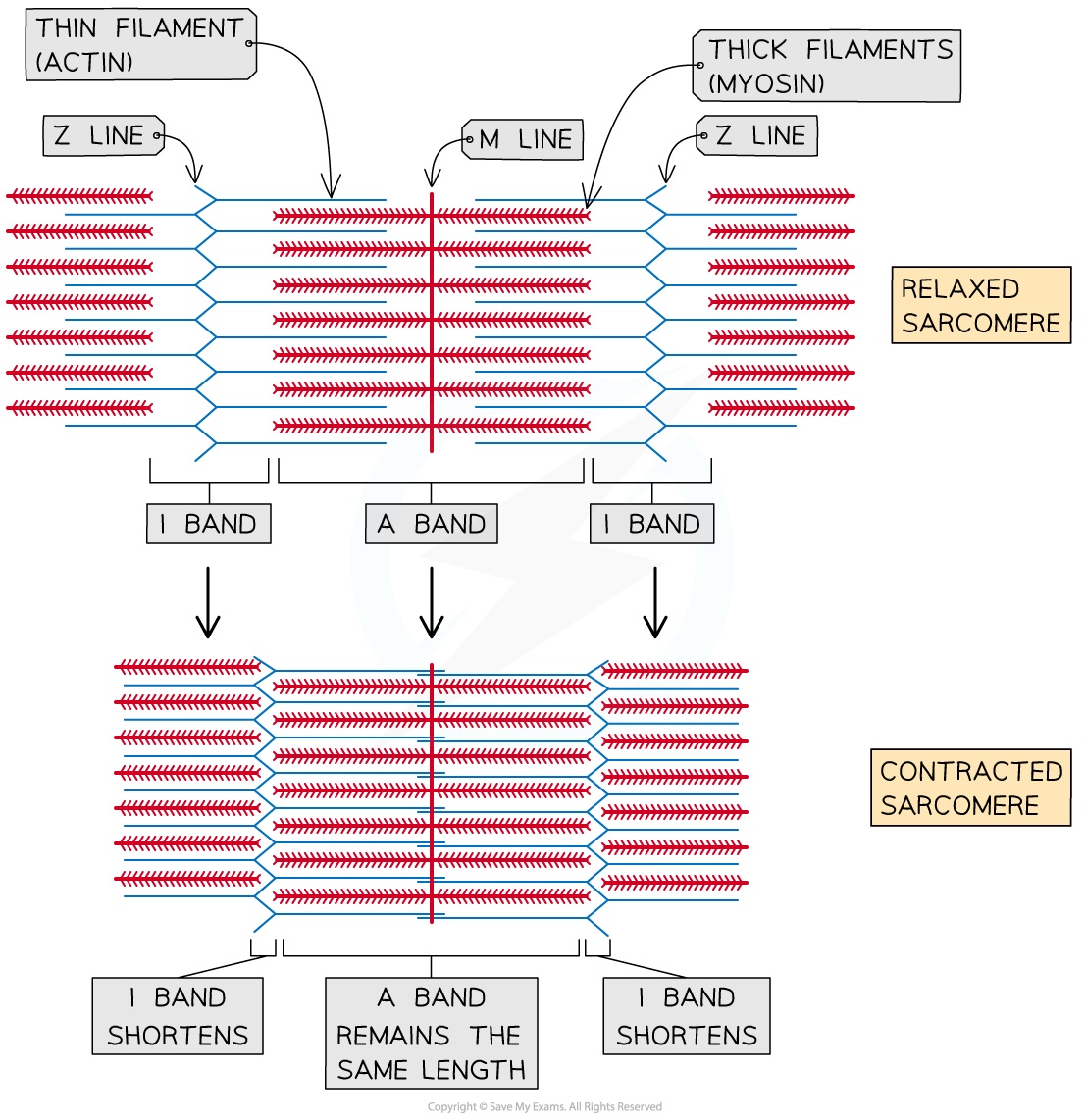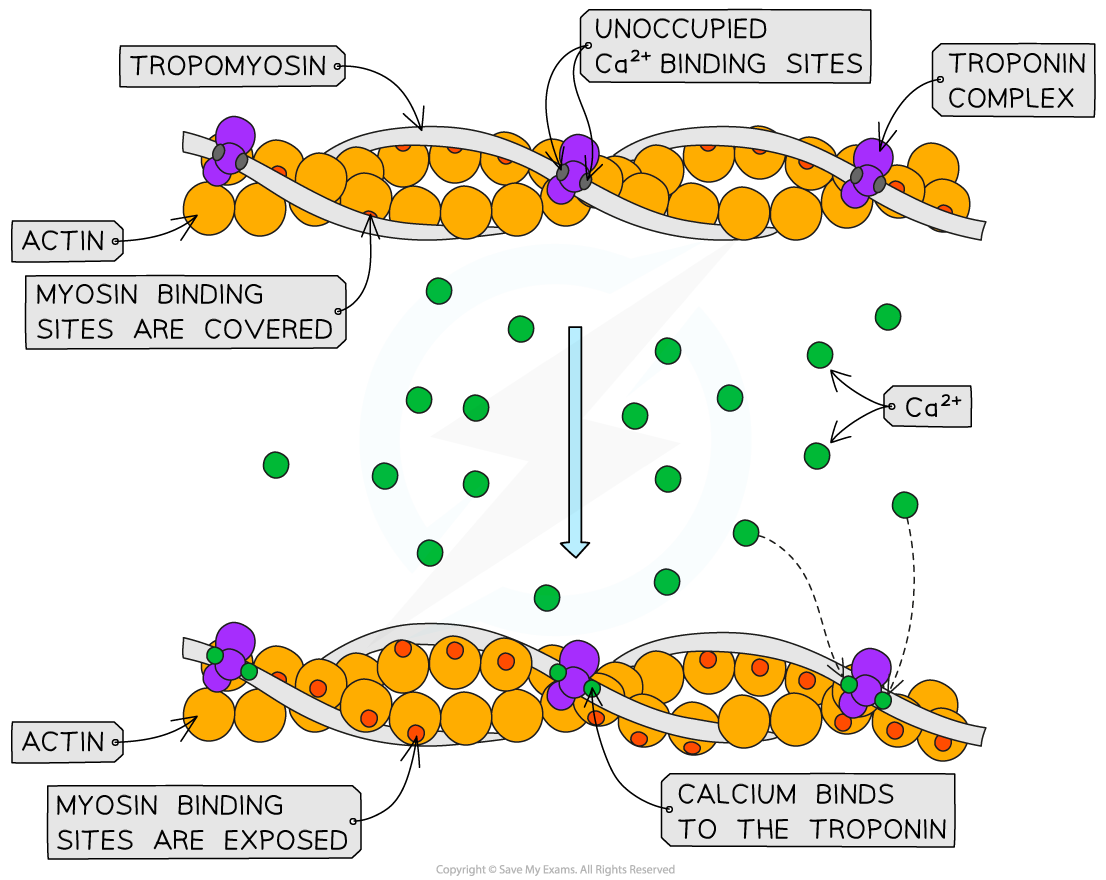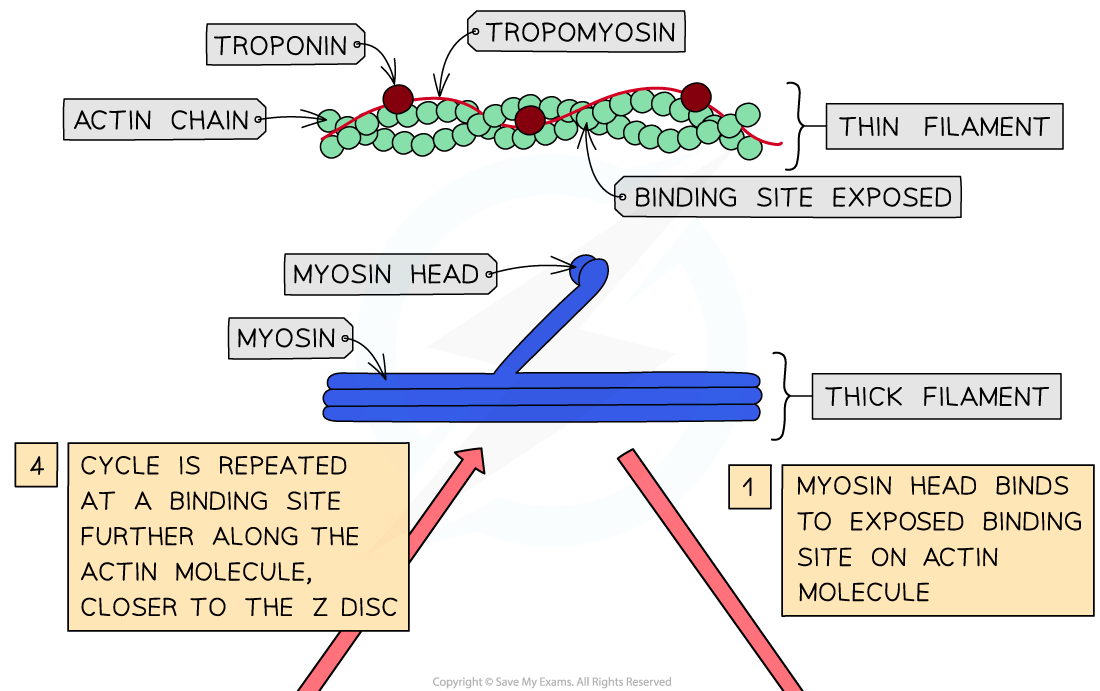Sliding Filament Model
- The thick filaments within a myofibril are made up of myosin molecules
- These are fibrous protein molecules with a globular head
- The fibrous part of the myosin molecule anchors the molecule into the thick filament
- In the thick filament, many myosin molecules lie next to each other with their globular heads all pointing away from the M line
- The thin filaments within a myofibril are made up of actin molecules
- These are globular protein molecules
- Many actin molecules link together to form a chain
- Two actin chains twist together to form one thin filament
- A fibrous protein known as tropomyosin is twisted around the two actin chains
- Another protein known as troponin is attached to the actin chains at regular intervals
- Muscles cause movement by contracting
- During muscle contraction, myosin heads form cross-bridges by binding with sites on the actin filaments
- The myosin heads then change orientation which pulls the actin filaments so that they slide next to the myosin.
- This is called a power stroke
- Sarcomeres within myofibrils shorten as the Z lines are pulled closer together

When the muscle contracts, the sarcomere shortens due to the sliding of the actin and myosin filaments.
Role of ATP and Calcium Ions in Muscle Contraction
- The sliding of the filaments, which facilitate muscle contraction, is dependent on a series of protein molecules as well as calcium and ATP
- Calcium drives the process in the following way:
- An action potential arrives at the neuromuscular junction
- Calcium ions are released from the sarcoplasmic reticulum (SR)
- Calcium ions bind to troponin molecules (found on the actin filaments), stimulating them to change shape
- This causes tropomyosin proteins to change position on the actin (thin) filaments
- Myosin binding sites are exposed on the actin molecules
- The globular heads of the myosin molecules bind with these sites, forming cross-bridges between the two types of filament
- The formation of the cross-bridges causes the myosin heads to spontaneously bend (releasing ADP and inorganic phosphate), pulling the actin filaments towards the centre of the sarcomere
- This is the power stroke
- This causes the muscle to contract a very small distance

Calcium binds to the troponin resulting in a change in shape of tropomyosin
- Effective muscle contraction occurs when many power strokes occur in quick succession; for this to take place, ATP is required
- ATP binds to the myosin heads producing a change in shape that causes the myosin heads to release from the actin filaments
- The enzyme ATP hydrolase hydrolyses ATP into ADP and inorganic phosphate which causes the myosin heads to move back to their original positions
- This is known as cocking of the myosin head or the recovery stroke
- The myosin heads are then able to bind to new binding sites on the actin filaments, closer to the Z disc
- The myosin heads move again, pulling the actin filaments even closer the centre of the sarcomere, causing the sarcomere to shorten once more and pulling the Z discs closer together
- ATP binds to the myosin heads once more in order for them to detach again
- As long as troponin and tropomyosin are not blocking the myosin-binding sites and the muscle has a supply of ATP, this process repeats until the muscle is fully contracted
- When the motor neurone stops sending impulses to the muscle fibre, calcium ions are actively pumped back into the sarcoplasmic reticulum and the tropomyosin moves back to cover the binding sites on the actin
- The muscle is now relaxed

 The sliding filament model of muscle contraction
The sliding filament model of muscle contractionExam Tip
The sliding filament model can be difficult to visualise fully with diagrams. To help you more clearly understand the steps involved, try to find some animations or videos of the sliding filament model online to see the movement of the myosin heads and thin (actin) filaments during muscle contraction!
Be sure to use the term calcium ions, rather than just calcium.
Be sure to use the term calcium ions, rather than just calcium.
Using Fluorescence to Study Muscle Contractions
NOS: Developments in scientific research follow improvements in apparatus - Fluorescence was used to study the cyclic interactions in muscle contraction
- Fluorescence is the emission of electromagnetic radiation after the substance has been exposed to a different wavelength of radiation
- Fluorescence has been used historically to study muscle contraction in organisms under the microscope by injecting them with fluorescent proteins, called aequorins, extracted from a jellyfish species, Aequorea victoria
- Aequorins are calcium sensitive and so react with Ca2+ ions released during the muscle contraction
- The interaction can be viewed under a microscope
- Autoradiography can also be used to show the presence of calcium isotope, calcium-45 during muscle contraction
- Calcium is present in the overlapping regions of the actin and myosin
- Here it binds to the troponin causing a change in the shape of tropomyosin, allowing the myosin to bind to the actin
- In a study of Nitella axillaris (a species of algae) cells, the mechanism of the sliding filament theory has been demonstrated by attaching a fluorescent dye to the end of myosin fibres
- Under microscope, the myosin was shown to 'walk' along the actin fibres during contraction
- This same method was also used to demonstrate the effect of ATP levels on the speed of the contraction and therefore show the dependence of the sliding filament theory on the availability of ATP
- When more ATP was present, the fibres moved at a faster speed than when there was less ATP present
